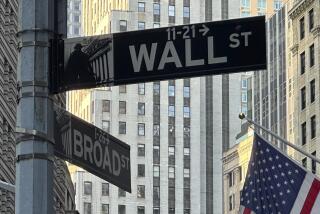No letup for oil, no relief for drivers
- Share via
Crude oil rocketed more than $10 a barrel Friday to a record high of $138.54, snuffing out motorists’ hopes that gasoline prices might ease soon.
“It’s like every time I look at the prices, they have jumped another 10 cents a gallon,” groused James Freedner, 57, of Sun Valley. “I just don’t know when this is going to stop.”
The biggest one-day surge ever in crude prices was fueled by a mix of factors, including a gloomy U.S. job report and interest-rate fears that drove down the dollar, unease in the oil-rich Middle East and a prediction by a major brokerage firm that crude could hit $150 a barrel by July 4.
“Never before seen, unprecedented, amazing, epic, all those fit to describe today’s [trading] session for crude oil and refined products,” Denton Cinquegrana of the Oil Price Information Service wrote in a report to clients late Friday.
The $10.75-a-barrel jump at the New York Mercantile Exchange followed Thursday’s increase of $5.49 and is expected to flow through quickly to the gas pump.
Motorists in California are paying a record average of $4.398 a gallon -- up 31% from a year ago and 12% in the last month, according to the latest AAA survey. The statewide average for a gallon of diesel -- burned by trucks, trains and other key components of the transportation system -- is $5.09 a gallon, 6 cents shy of its recent record.
“I’m expecting a 10-cent increase for my gasoline from Shell today,” said Andre van der Valk, who owns four gas stations in Southern California and was selling regular for $4.499 a gallon.
“From the consumer end of it, it’s a killer.”
Freedner, who works as a legal secretary, knows all about that. High gas prices prompted him to cancel his annual Memorial Day trek to his cabin in San Benito County.
“I pity the people who really have to drive long distances, and I think a lot of people are doing what I’m doing, which is to just decide not to travel as much,” he said. “You try to roll with the punches, but it’s getting more and more annoying.”
After hitting a then-record close of $133.17 on May 21, the price of oil had eased somewhat in recent weeks as the dollar firmed and demand for gasoline fell 6% in May compared with last year. But the doubling of crude prices over the last year is clearly showing up in many areas of the U.S. economy.
Airfares have taken off as carriers try to cope with high jet-fuel costs, and food prices have climbed along with the cost of operating farm equipment and buying petroleum-based fertilizers. Prices for plastics -- made from oil and ubiquitous in American life -- are soaring.
“Oil is not only the lifeblood of our society, but a fundamental component of the things we take for granted every day,” said Robbie Diamond, head of Securing America’s Future Energy, a group that advocates energy independence for the U.S.
Besides the recent drop in driving -- the Federal Highway Administration said travel on public roads fell in March for the first time since 1979 -- there are other signs that high oil prices are affecting behavior, experts say. Telecommuting is on the rise, more companies are asking employees to work a four-day week to reduce commuting, public transit ridership is up, and Americans are vacationing closer to home or not at all.
“For working-class folks, it’s just a lot of bad news,” said Sean Brodrick, an analyst for the newsletter Money and Markets. “The U.S. consumer is headed for more pain, and the U.S. economy is headed for a lot more hurt.
“I think you are going to find that people are spending those economic stimulus checks on things like groceries and gasoline, and that is not the kind of thing that stimulates the economy.”
Market watchers said the trigger for the latest two-day surge came from Europe, where officials hinted that higher interest rates were needed to combat inflation. That move would further weaken the value of the dollar and boost the price of oil, which is traded in dollars.
The dollar slumped against the euro Friday when the U.S. government reported that the country’s unemployment rate jumped to 5.5% in May -- much higher than expected. A dramatic weakening of the U.S. economy makes it less likely that the Federal Reserve will boost interest rates, further undercutting the greenback.
Other factors included unrelenting oil-futures speculation by large investors, a suggestion that Iran’s pursuit of nuclear technology could trigger an attack by Israel and the $150-a-barrel prediction from analyst Ole Slorer at Morgan Stanley, an investment bank that is one of the most active players in energy commodities markets. Slorer based his prediction on brisk demand in Asia.
“A lot of people in the market had been selling, expecting prices to bump down, then we got this prediction today for $150-a-barrel oil,” said Bruce Bullock, executive director of the Maguire Energy Institute at Southern Methodist University in Dallas.
“Traders got spooked, and that helped drive the market even further. I don’t think it’s all market speculation, but it does add to the volatility.”
--
martin.zimmerman @latimes.com
--
elizabeth.douglass @latimes.com
--
--
Times staff writer Walter Hamilton in New York contributed to this report.
More to Read
Sign up for Essential California
The most important California stories and recommendations in your inbox every morning.
You may occasionally receive promotional content from the Los Angeles Times.











